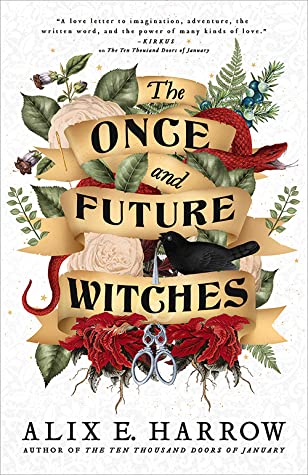- The Good: Suffragettes, but they’re witches!
- The Bad: Strong female representation but only one rep for LBGTQ and one for POC
- The Literary: Reimagined histories, stories, and folkore
The Eastwood sisters, June, Agnes, and Bella, reunite in New Salem in 1893, their relationships strained. But when June convinces the others to join the suffragist movement, their decision leads them to pursue the lost ways of witching. There used to be witches, before the burnings, and all that now remains are small charms. Many will not suffer a witch to live, let alone vote, forcing the sisters to pursue even older magics as they heal the rift between them.
Nestled in this 1890s alt-America, where the battle for women’s suffrage is also a battle to restore women’s magic, is a lovely story about estranged sisters who forgive and begin to understand one another. It’s a great character story featuring three very different women. Introduced as the wise one, the strong one, and the wild one, they become so much more, still themselves, but nuanced, eventually subtly representing each of the female archetypes of mother, maiden, and crone.
Bella is the oldest, a librarian and lesbian; Agnes is the middle child, a street-savvy factory worker; June is the youngest, wild, scrappy, abandoned by her older sisters to live alone with an abusive father. It’s June who is passionate about women’s rights, but she’s the one kicked out of the New Salem Women’s Association for also campaigning for witches’ rights. Instead she joins the newly formed Sisters of Avalon who does just that, along with attempting to discover ancient and powerful spells.
As the sisters’ worlds and views expand and they share secrets of their past, their broken relationships heal, paralleling the discovery of the lost secrets of witching. The witchcraft itself, at least women’s spells, center around traditional women’s work, including housekeeping and childcare, and many of the spells passed down through the generations are hidden in nursery rhymes.
To give weight to the magic and world-building, the chapters are interspersed with witchy folklore and stories, favorites re-imagined both in content and historical context: The Sisters Grimm, Charlotte Perrault, and Andrea Lang collect fairy tales. A popular writer of detective fiction is Miss Doyle. Anansi becomes Aunt Nancy. (Speaking of African folklore, there is some commentary on the racism of the Women’s Movement, and Bella’s love interest is a black woman, but I would love to see more of the characters of color.)
The writing is earnest and charming, with a feminine grace, while at the same time projecting a fierce, wild need for resistance and progress. I love the tone of this book. It’s fun and touching, with intimate relationships as well as a revolution. Highly recommended for fans of historical fiction, magic, and feminism.
